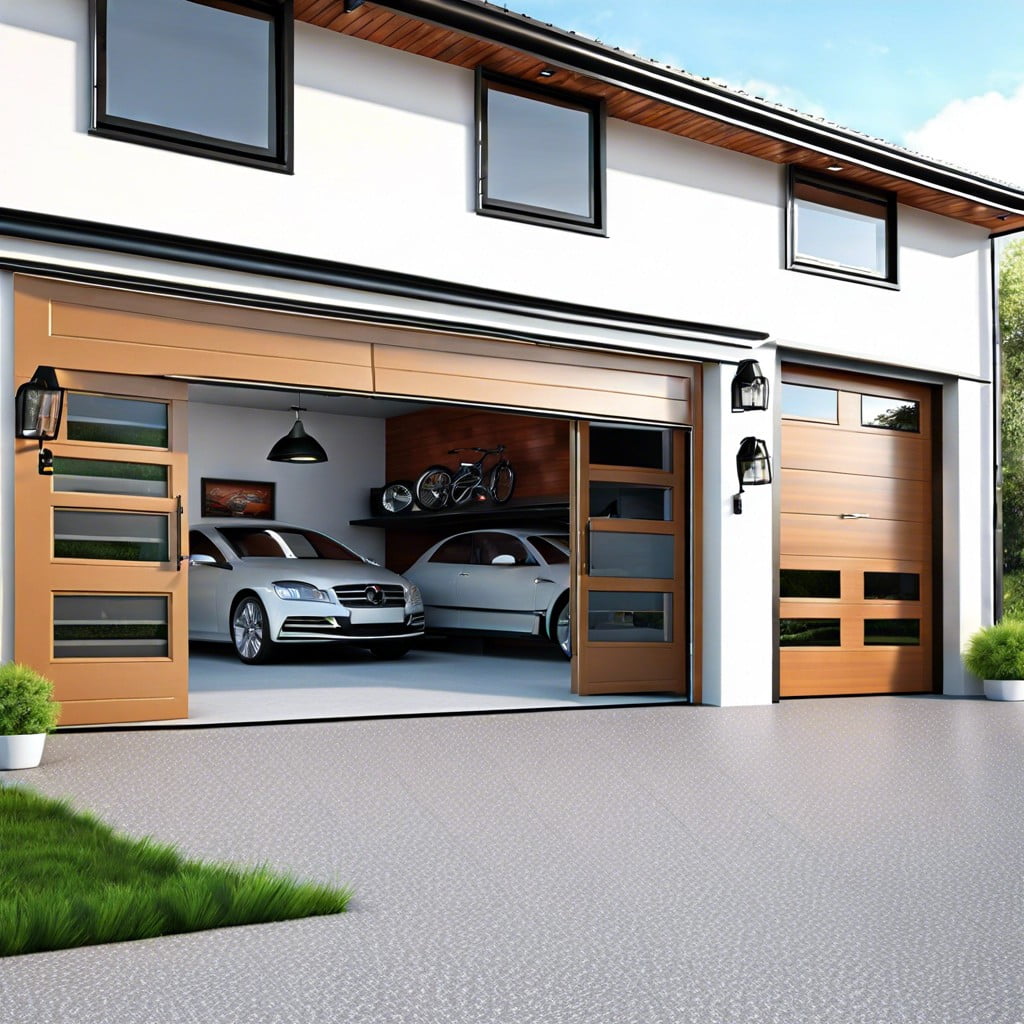Get ready to find out everything you need to know about choosing the perfect garage door for your home, including materials, styles, and key features.
Key takeaways:
- Types: Choose sectional, roll-up, side-hinged, tilt-up garage doors.
- Insulation: Look for high R-value, good seals for energy efficiency.
- Security: Rolling code, alarms, steel, automatic locking for safety.
- Maintenance: Check hardware, balance, lubricate, test auto-reverse.
- Smart Tech: Smartphone control, voice activation, alerts, integration for convenience.
Types of Garage Doors

When it comes to options, garage doors have more variations than a chameleon in a paint shop. One popular style is the sectional garage door, which consists of panel sections connected with hinges. As the door opens and closes, the wheels at the edge of each panel roll inside a vertical track on each side of the door opening.
Then there’s the roll-up garage door. Think of it like a giant, metallic burrito for your garage. Ideal for spaces with limited ceiling room, these doors roll up neatly into a coil, making them perfect for commercial use.
You might also stumble upon the charming side-hinged doors. These old-school beauties swing open and closed from a hinged frame on either side of the opening. Though they invoke nostalgia, they’re also highly practical for garages doubling as workshops.
Lastly, the tilt-up canopy and tilt-up retractable doors. These doors operate as one solid piece, tilting up into the garage ceiling in a single motion. The canopy version leaves about one-third of the door protruding beyond the front of the house when open, while the retractable version tucks away completely.
There you have it. With these choices, your garage door can be anything from a functional entrance to a statement piece.
Insulation and Energy Efficiency
When you’ve got a garage that’s more freezer than fortress in winter, insulation is your best friend. An insulated garage door is key to maintaining a comfortable temperature inside, whether you’re turning wrenches or using the space for that long-promised workout.
First, look for the R-value. The higher the R-value, the better the insulation. It’s like a cozy blanket, but for your garage.
Next up, consider the material. Steel doors with injected foam insulation or wood composite doors with polystyrene cores perform well. Less heat leakage means lower energy bills—more money for those DIY projects you’ve been dreaming about.
Seals and weatherstripping are the unsung heroes here. They prevent drafts and keep the cold or heat where it belongs: outside. A good bottom seal stops water, dirt, and small, unwanted critters from sneaking in.
Think of it this way: better insulation equals a more comfortable garage, and a more comfortable garage equals more reasons to hang out in it. Beats the polar bear experience any day.
Security Features
A garage door acts as the frontline soldier protecting your precious tools, cars, and perhaps even that secret stash of vintage comic books. Modern doors come equipped with various security features to keep intruders at bay.
First, rolling code technology ensures that the same code is never used twice, making it virtually impossible for thieves to crack the entry code.
Next, integrated alarm systems can sense any unauthorized tampering, setting off a loud siren that’ll send burglars running faster than a cat near a cucumber.
Additionally, sturdy materials like reinforced steel offer a formidable barrier that’s as tough as a security guard on a caffeine high.
Lastly, automatic locking mechanisms ensure that the door locks itself every time it closes. No more late-night runs to double-check the garage.
These features together provide a robust defense against unwanted guests, letting you sleep soundly knowing your treasures are safe and sound.
Maintenance Requirements
Dust off your toolbelt, because keeping your garage door in tip-top shape doesn’t have to be a Herculean task. A little TLC goes a long way.
First, check the hardware. Tighten any loose bolts and screws. Garage doors have a lot of moving parts, and a tightened bolt can prevent a whole lot of rattling and rolling.
Next, inspect the balance. Disconnect the opener and manually lift the door halfway. If it stays put, it’s balanced. If it doesn’t, time to call a pro.
Lubricate moving parts. A little grease on the springs, rollers, and hinges can prevent any medieval creaking and extend your garage door’s life.
Finally, test the auto-reverse feature. Place a block of wood in the door’s path and close it. It should reverse immediately upon hitting the block. If not, adjust the opener’s settings or get it looked at.
Voilà! With these simple steps, your garage door will stay smooth and quiet, ready to tackle another day of hiding your clutter from the neighbors.
Smart Technology Integration
Integrating smart technology into your garage door can make life significantly easier and more secure. First off, imagine controlling your garage door from your smartphone. No more racing back home to check if you left it open; a simple app can confirm and remedy that in seconds.
Voice control is another feature that’s catching on. With devices like Amazon Alexa or Google Assistant, you can open or close your garage door without lifting a finger. “Alexa, did I leave the garage door open again?”
Alerts are also incredibly handy. Receive notifications when your garage door is opened unexpectedly, adding an extra layer of security. You can even grant temporary access to visitors or service personnel directly through an app, avoiding the need to hand out spare keys.
Then there’s the potential for integration with other smart home systems. Link your garage door to your home security system, lights, or even your thermostat. The door opens, the lights come on, and the thermostat adjusts to welcome you home—now that’s smart living!
Incorporating these features not only enhances convenience but also elevates the overall safety and functionality of your garage.